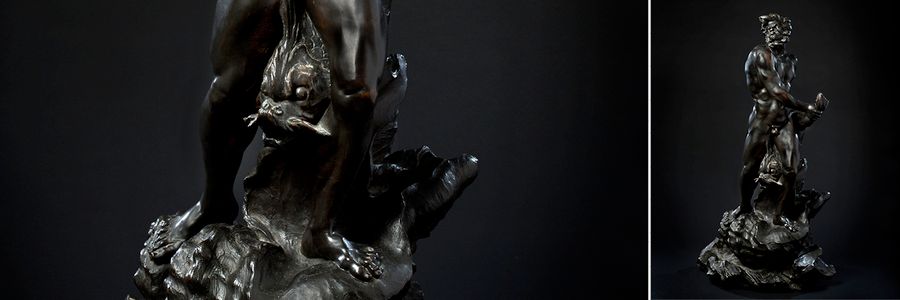PRECIOUS REDISCOVERY OF A BRONZE
FROM BERNIN: BETWEEN PAROXY OF EXPRESSION AND THEATRALIZATION OF THE SPECTACULAR
If the seventeenth century marks a quest to correct the official taste to satisfy the classical regularity of the ideal "beauty" in art, some artists tend to free themselves from this perspective that is losing expressiveness. Such is the maxim of Gian Lorenzo Bernini, known as Bernini (1598-1680), who is ineluctably linked to the Italian Baroque artistic movement. Its figurative singularity oscillates between grandiose and dramatic.
An eminent virtuoso of sculptural art, the master responsible for a singular career punctuated by pontifical and aristocratic commissions reveals the expressiveness of his creative genius. His work is a rare bronze reduction after Bernini of the fountain known as the Moor in Piazza Navona in Rome,
The rediscovered bronze of the Triton riding a dolphin carries with exact similarity the plastic characteristics of the museum work. It can be compared to the terracotta modello by Bernini acquired in 2003 by the Kimbell Art Museum. The Fountain of the Moor in Piazza Navona and the eighteenth- and nineteenth-century bronze reductions of it that we know of so far only present an iconography in which the Triton floats on the waters of the basin, as in the Piazza Navona. The bronze representation that we present is rather different: identical to the modello of the Kimbell Art Museum by this singular platform forming a pedestal of rocks. There are no drawings or engravings to illustrate this representation of conches. This thus attests to the major significance of this rediscovery of our large bronze, which could only have been made from the recently rediscovered modello in the Kimbell Art Museum.

.jpg)
Fig. 1 Fig. 2
Fig.1
Gian Lorenzo BERNINI
Model for the Moor's Fountain, 1653
Terracota, 80.5 x 42.5 x 41.9 cm,
Kimbell Art Museum, Fort Worth
Fig. 2
After Gian Lorenzo BERNINI, known as LE BERNIN (1598-1680)
Triton riding a dolphin, standing on a large conch among the rocks.
Bronze with brown patina. Lost wax (in two parts).
Bronze reduction of the Moorish fountain in Piazza Navona, Rome.
France or Italy, probably 18th century.
Height : 77,6 cm - Width base : 36,1 cm - Depth base : 43 cm
It is therefore clear that the artist who formed the wax that was used to make our unique bronze had Bernini's chief model in terracotta before his eyes, which has been kept in the Kimbell Art Museum since 2003. They are indeed comparable in size. We also note that the majestic triton in our bronze has two arms, which the original terracotta does not have. Finally, we note that the figurative and material scope of this bronze attests to the unquestionable prestige of the patron.
By refusing classical norms such as the quest for regularity in classicism, the bronze after Bernini invokes the indefatigable paradigm of the artist who transcends the material through the expressiveness of his creative genius. We will have the pleasure of presenting it to you during our June 30 vacation.

Fountain of Piazza Navona, Rome
CLASSICAL ARTS
Auction
Thursday, June 30, 2022, at 2:30 pm
Aguttes, Neuilly
Grégoire de Thoury
Head of the Furniture & Objects of Art Department
+33 1 41 92 06 46 • thoury@aguttes.com



